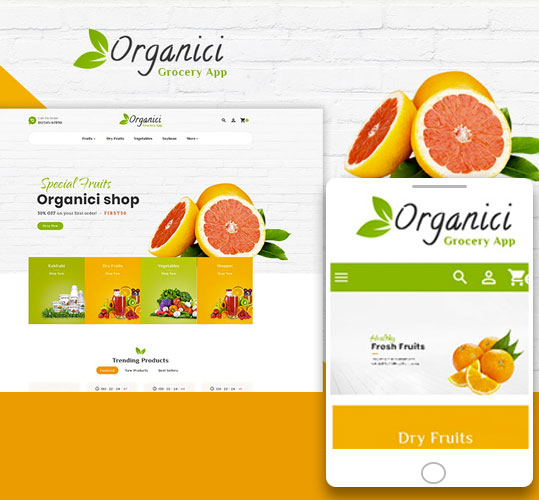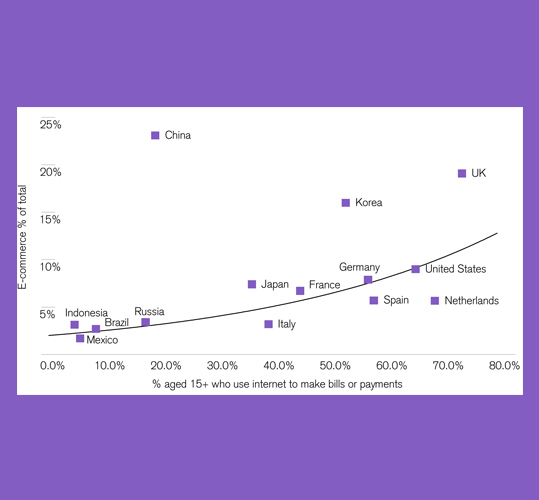The Emerging Consumer Survey 2018 shows that today’s emerging consumers are just as connected as their peers in Europe or the USA, and are as likely, if not more so, to opt for online retail services. Smartphones are a key driver for online access.
The rapid adoption of smartphones and subsequent access to the internet has allowed emerging market consumers to be a major global force across a range of online activities including online retail, gaming, and eSports. Internet access among Emerging Consumer Survey respondents is now around 80 percent or more in all countries except Indonesia and South Africa. Quite clearly, lower average spending power has not deterred consumers across our emerging economies to gain access to the internet and start benefiting from its range of services. In conjunction with total population sizes, it clearly makes them stand out among the economies surveyed as the biggest online retail markets.
There is huge growth potential for online retail. The current online spending of around USD 1.29 trillion across the economies surveyed would increase to around USD 2.7 trillion if the share of online retail spending were to increase to just 25 percent in China and 15 percent elsewhere, and assuming that total retail spending increases at 5 percent per year.
Many factors are indicating that online retail spending across emerging markets is far from played out.
Urbanization Coincides with Greater Propensity to Shop Online
As urbanization is set to continue to rise across emerging markets, it should coincide with a growing share of online consumer spending in our view. This is because greater urbanization and population density help to ease the logistical challenges that online companies face when developing their services.

Mobile Adaptivity
More and more web traffic is generated by smartphones and tablets, driving eCommerce sales. Many major brands make sure that their websites are mobile-adaptive—improving the customer experience—and more often than not they have native mobile apps to make shopping even easier for customers. If your website is not a tablet and mobile adaptive, you will definitely be losing the youth of Generation Z and millennial customers.
Moreover, technological improvements such as better connectivity and voice-activated shopping have caused a surge in mobile shopping income from $3 billion to $31 billion in America only. Customers get real-time updates of new product launches, exclusive deals, and promotional schemes, and the one-touch purchase option has caused an exponential growth in eCommerce.
Smartphones additionally permit for location-explicit offerings, building a more intimate customer-business relationship that drives more customers.
Think about hiring a technical support expert or an eCommerce support virtual assistant to easily transition into this new phase of online commerce.
Omnichannel Retailing
Ecommerce has progressed beyond search engine optimization to other channels of marketing to and interacting with customers. Businesses connect with their shoppers via websites, social media, email, and physical stores. This creates multiple channels of purchase, receipt, and exchange of goods, with a prevalence of shopper-friendly shipping and return policies. Customers can purchase online, pick their purchases up at a physical store, return any defective items online, and avail discount offers based on a certain number of referrals. This blended physical and online experience drives more sales.
Your business must manage the omnichannel customer experience so that each channel is a seamless brand extension and the customer can pick up the conversation on any channel without any discordant experiences.
Convenience
Ecommerce promises 24/7 accessibility, 365 days a year, with no downtime for public holidays, closing times, bad weather conditions, etc. Customers can shop whenever they love, from wherever be it the comfort of their own bed. Ecommerce makes purchasing faster and easier, without the hassle of crowds, traffic, and awkward social interactions.
Customers can compare offerings online and read up reviews to see how the product or service fared in the view of like-minded individuals to determine which offer has the best value, all without having to go from one shop to the other.
The ability to discover the desired service or product, order it, and get it at the time and in the form convenient to the shopper at a single touch or click has changed buying behavior, encouraging instant gratification and thus increase eCommerce transactions. In this fast-paced world eCommerce, today offers the value proposition of a full shopping experience during the only real free time available to millennials—long commutes.
To take advantage of this trend, your website should be search-engine-optimized, have fast loading speeds, should have a functional shopping cart, and have updated product catalogs. Most importantly, your customer service must be par excellence and for eCommerce especially, it should extend to 24-hour call center support since the majority of buyers shop after business hours. This will also significantly enhance your reputation.
FMCG and Food Delivery to Support Growth
At present, online shopping is dominated by more price-elastic consumer items such as books, electronics or apparel. Going forward, however, we expect stronger online retail growth to be generated by so-called fast-moving consumer goods (FMCG), such as beverages, food or toiletries. To indicate the upside potential of FMCG, we note that, in Europe, only 2.4 percent of grocery sales are made online compared to over 12 percent of other retail sales. Not only is the share of FMCG and groceries purchased online very low (with the exception of China), but continued urbanization should also help to lower logistical challenges.

Traditional Retailers Developing Online Capabilities
Given their dominance in terms of market share, it seems that only a few companies have been quick to realize the demand potential for e-commerce services. As a result, companies such as Amazon have been able to grab market share, leaving traditional retailers under significant pressure due to their lack of online presence. Recently, omnichannel strategies (e.g. offline retailers developing online capabilities) have become increasingly popular. For example, Google and Walmart are cooperating in the US, while Lidl has set up a collaboration with DHL in Germany. These developments are likely to intensify competition among the various companies active in the segment, but should still allow for continued growth in online consumer spending.
Pure-Play Online Companies Expanding Offline Offerings
Though connectivity and mobile access are the most relevant factors for more traditional purchases, other factors such as improved delivery logistics, ease of buying and retailer presence are also relevant, not least in the area of online FMCG.

Some of the key online players have realized that they need to expand their service offering to cater to these consumer demands. Improving consumer access and convenience should help grow e-commerce revenues further as “saving time” is one of the key reasons why consumers buy online according to Nielsen.
Cross Border Ecommerce As an Additional Driver
Greater connectivity allows consumers to become familiar with products and services that are not necessarily produced locally. According to Nielsen’s 2017 Online Shopper Trend Report, the share of Chinese consumers who buy products from overseas websites has doubled to 64 percent since 2014.
Although the share of Chinese consumers who buy from overseas websites is rising, the lion’s share of their buying remains domestically focused leaving lots of potential for further development.
Data Analytics Can Drive Online Revenues Further
The proliferation of the number of online sales channels (e.g. desktop, mobile, tablets) implies a growing need for advertisers and retailers to understand consumer behavior across these channels in order to maximize the benefit from online sales. Technology, and specifically data analytics, can help in this regard as these allow for the optimization of consumer marketing, which in turn should help drive online commerce growth further.
Greater Adoption of Mobile Payments in Emerging Markets Drives Growth
Owing to the development of internet access and smartphone ownership, digital non-cash payment systems are possible. At the same time, the intensity of a country’s e-commerce activities correlates with the willingness to make non-cash payments. India is likely to follow China, where the share of cash in retail transactions has fallen from 61 percent in 2010 to 38 percent in 2016. At the same time, the share of mobile-based payment transactions has increased to more than 11 percent in China from zero five years ago.

Greater Range of Offerings
With incredibly low overheads like negligible utility bills, skeletal staff, and the ability to provide a product or service from any location to a worldwide customer base, eCommerce dramatically reduces costs of operations. This allows businesses to transfer some of these onward to price-sensitive customers in the form of cheaper products with automatic replenishment since warehouses are no longer restricted to certain geographic locations.
Ecommerce also allows businesses to outsource their administrative backend operations to specialist support services providers located virtually anywhere in the world.
So move with the times and lower your overhead costs by partnering with firms that provide administrative support, backend, and operational support, allowing you to focus on your core competencies and grow your business.
Ecommerce growth correlates with non-cash payments
The speed of technological progress and the subsequent sharp decline in the cost of technology has allowed emerging consumers to leapfrog various stages of development compared to consumers in developed markets. There is every reason to believe that there is still much to come in this area.







